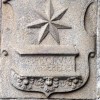- Accede I
- Regístrate I
- carrito
Hacia la Ciudad Santa
Los motivos para emprender la peregrinación son numerosísimos. El Papa Calixto II, en 1122, en medio de la difusión de las reformas gregorianas, instituyó el Año Santo cada vez que la festividad de Santiago, el 25 de julio, cayese en domingo. En 1179 la bula del Papa Alejandro III otorgó la indulgencia plenaria a quien peregrinase en tales fechas: la visita de una tumba apostólica, que de por sí habría bastado para movilizar a los fieles, estaba ahora recompensada con la promesa de la salvación.
Para atender a los caminantes, surgieron monasterios, iglesias, hospitales, refugios, puentes y calzadas, muchos de los cuales, al congregar a cierto número de población rural del entorno, se convirtieron en nuevas ciudades. Jugaba a favor la necesidad de repoblar los territorios recién arrancados al Islam, que condujo a que a los reyes cristianos ofrecieran cartas de libertades y privilegios a quienes se instalaran en la ruta.
No es por ello extraño que en los siglos XII y XIII la historia hable de multitudes de hasta 250 mil peregrinos movilizados cada año, la mayoría movidos por la inquebrantable fe y la búsqueda de la salvación a través de la penitencia; algunos otros por el cumplimiento de una pena, y unos pocos por ganar dinero peregrinando en nombre de algún poderoso. A todos les distinguía el atuendo –bastón o cayado con calabaza para beber, bolsa, sombrero – pero sobre todo la concha, natural, de plomo, estaño o plata, que distinguía a los peregrinos que la adquirían en principio sólo en Santiago, y luego ya en el resto del Camino. Sobre su significado son muchas las versiones: las primeras vieiras habrían sido recogidas en el Finisterre, justo en tierras de la evangelización de Santiago, por lo que representarían la culminación del Camino, el encuentro con el Maestro y con la salvación. En lo sucesivo fueron además señal protectora, pues era un delito penado atacar o robar a un peregrino que la portara.
Tras el declive sufrido por las peregrinaciones a partir del siglo XIV, primero por las pestes, y luego durante las guerras religiosas del siglo XVI y la expansión del espíritu de la Ilustración, hoy en día se puede hablar de un verdadero resurgir del fenómeno, a lo que sin duda contribuyó la peregrinación de Juan Pablo II, que visitó Santiago en 1982. El Año Santo de 1993 trajo a Compostela más de 100 mil peregrinos a pie, en bicicleta o a caballo, cifra que se elevó a más de 150 mil en el siguiente Año Santo de 1999, a 180 mil en 2004 y a 270 mil en 2010. La cifra de los últimos años no jubilares sigue superándose en relación con años precedentes, por lo que se espera que el Jubileo del 2021 convoque a centenares de miles de caminantes y a millones de visitantes movidos por la fe, el deseo de ver mundo y de vivir el Camino en solitario o en compañía.
A quienes logran llegar por sus propias fuerzas Santiago, les espera, en cualquier año, la recompensa de la Compostela, un diploma extendido por la Oficina del Peregrino para certificar que la ruta ha sido hecha con sentido cristiano. Lo obtienen los peregrinos que cubran los últimos 100 kilómetros a pie o a caballo, y los que en bicicleta recorran los últimos 200. En ambos casos debe portarse la credencial oficial de peregrino con uno o más sellos diarios de los albergues o las parroquias recorridas por cualquiera de sus rutas.









